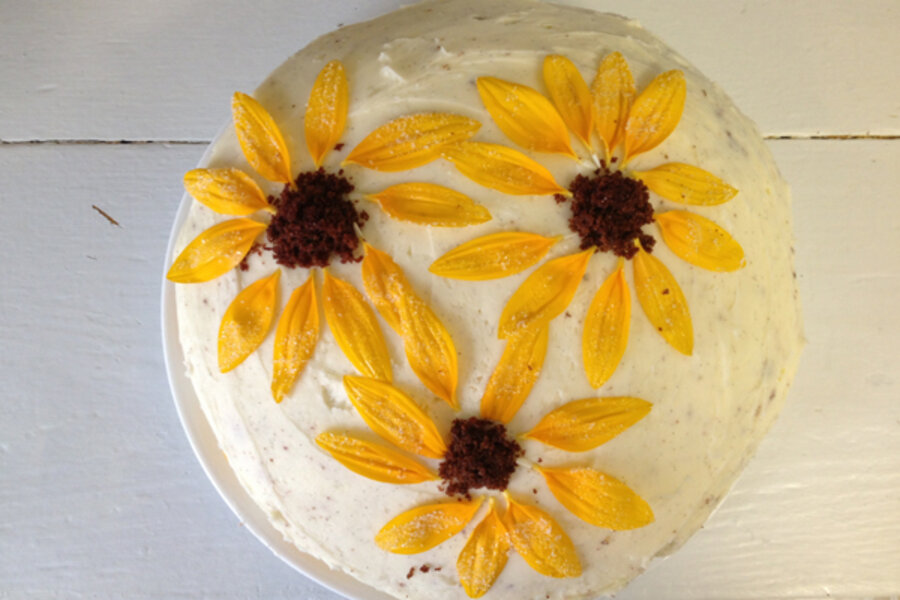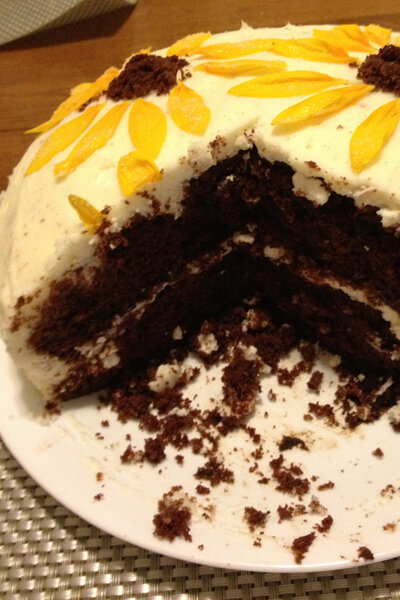Birthday cake mishaps and sugared flowers
Loading...
For some people, birthdays aren't really a big deal. I have never been one of those people.
My birthday is the first week of September, so after July 4 passes, it's the next big holiday on my calendar, and I can officially start planning my cake. (As previously stated, there is no shame in baking your own birthday cake.) After much deliberation, I decided to modify a Peppermint Patty Cake by Ree Drummond, The Pioneer Woman. I'm not a huge fan of chocolate and peppermint together, but I had been looking high and low for a recipe for a chocolate cake with vanilla buttercream frosting so I could use sugared flowers for decorations, and I figured leaving out the mint flavored-ingredients in this recipe wouldn't be too difficult.
I'm a huge fan of modifications, substitutions, and experimentation in cooking, but not so much for baking. Everyone knows baking is the most delicious branch of science, and requires equal parts concentration, precision, and perspiration. So adapting this recipe made me nervous – really nervous.
For the cake, I swapped 10 whole miniature Peppermint Patties for 5 blocks (or 1 8-ounce box) of semi-sweet baker's chocolate. I also left out the mint extract. For the frosting, I swapped the mint extract for vanilla extract, and used 1 vanilla bean instead of two, and increased the baking time.
I removed my cakes from the oven fully baked, not burned, and doubly chocolatey, feeling a mixture of pride and astonishment that I didn't totally mess this one up. Then came the disastrous removal of the cakes from their pans. The Pioneer Woman warns that these cakes stick badly, but I was confident my buttered and floured nonstick pans would be fine. Alas, my cakes chipped, crumbled, and cracked upon removal. I should have heeded my mother's nagging voice in the back of my head warning me to never, ever, ever, EVER bake a layer cake without cutting wax paper circles to fit the bottom of your cake pans. After some deep-breathing exercises I calmly saved the cake crumbs, and resolved to spackle everything back together with frosting.
The next morning a moment of inspiration struck and I decided to use the leftover cake crumbs as the center of my "sunflowers" in the decorating process. Sunflower petals are 100 percent edible, and with a quick egg white wash and a sprinkle of sugar they were ready to go. While not quite as professional-looking as the decorated cake I made last year, I thought my sunflower topped-cake came out pretty darn cute (never mind that beneath all the frosting the cake was in about 20 pieces).
Oh, and did I mention it was delicious?! The cake was moist and extra-chocolatey, but the real star was the vanilla bean buttercream frosting. Set aside your concerns about 4 sticks of butter (it's your birthday after all!) because this icing is heavenly and worth every calorie.
I read up on the "crumb layer" in the frosting process, where you frost the cake thinly to trap all the crumbs, then refrigerate it for half an hour, and frost it again for a more beautiful finish. This frosting works great for this process, hardening up nicely. I could also see how the mint extract would work well with it's subtle vanilla flavor, if you are a Peppermint Patty type of person and want to give that version of this cake a whirl.
Double chocolate layer cake
Adapted from The Pioneer Woman's peppermint patty cake with vanilla mint frosting
1 cup boiling water
2 sticks butter
4 heaping tablespoons unsweetened cocoa powder
1 box (8 ounces) semi-sweet baker's chocolate
1/2 cup buttermilk
1 teaspoon baking soda
2 eggs
1/2 teaspoon vanilla extract
2 cups flour
2 cups sugar
1/4 teaspoon salt
Sugared sunflower petals
1 large sunflower
1 egg white
3-4 tablespoons granulated sugar
Special supplies: small paint brush and wax paper
Vanilla bean buttercream frosting
6 cups powdered sugar, sifted
4 sticks butter, softened
1 large vanilla bean, caviar scraped out
1 dash salt
4 tablespoons half-and-half
1/4 teaspoon vanilla extract
1. Preheat oven to 350 degrees F. Grease and flour two round cake pans. Cut two circles of wax paper and line bottoms of floured cake pans.
2. In a small saucepan or the microwave, bring 1 cup water to a boil. Meanwhile, in a medium saucepan, melt 2 sticks of butter and whisk in 4 tablespoons cocoa. Pour in boiling water, let the mixture bubble up for 30 seconds, then turn the burner to low. Add baker's chocolate and stir until melted. Remove pan from heat and set aside to cool.
3. In a measuring cup mix together the buttermilk, baking soda, eggs, and vanilla extract. Set aside.
4. In a large mixing bowl, whisk together flour, sugar, and salt. Pour chocolate mixture into the bowl, stirring to slightly cool it. Pour in the buttermilk mixture and whisk until smooth.
5. Pour batter into prepared cake pans and bake for 16-18 minutes, or until done (my baking time was closer to 22-25 minutes). Remove cakes from oven, and let cool in pans 2-3 minutes. Carefully run a butter knife around the edges of each pan, using pot holders, invert cakes on wire cooling rack, peel off wax paper, let cool completely.
6. Make the sugared flowers: Pluck all the petals from from the sunflower. Rinse thoroughly in a colander, and pat dry with a paper towel. Separate egg white into small bowl, and measure sugar into another. Spread a piece of wax paper on your work surface.
7. Working in small batches, 5 or 6 petals at a time, use the paintbrush to apply egg white to both sides of each petal. Place them on wax paper as you work, and when you have a few brushed, "dip" or drag them in the bowl of sugar. Repeat until all petals are sugared. Leave them spread out on wax paper until ready to use.
8. Make the frosting: Measure and sift powdered sugar into large bowl. (If you're like me, and don't have a sifter, use a whisk to break up any clumps of sugar.) In bowl of stand mixer (or with hand mixer) beat the butter until fluffy. Slice open the vanilla bean, scrape out caviar, and add it to the bowl. Slowly add powdered sugar; turn off mixer completely, add a little sugar, then mix on a low for a minute until sugar is incorporated, then mix on high for a minute. Repeat until all sugar is mixed, then add salt, and beat until fluffy. Add half-and-half and vanilla extract and beat until totally fluffy.
9. Decorate the cake: Level the first layer, and place it flattest side up on a platter or cake stand. Set aside the extra cake crumbs. Slide little strips of wax paper under the first layer of cake to keep your plate clean of icing. Spread a good layer of icing on top of the first layer of cake. Level the second layer of cake, and place it flattest side up on top of the first layer. Thinly ice the top and sides of the cake, leaving a good amount of icing in the bowl (and being sure not to mix cake crumbs in the icing bowl).
10. Refrigerate the cake for at least half an hour. Do not refrigerate the frosting. (Now's a good time to tackle cleaning up part of your kitchen.) Remove the cake from fridge, and frost the top and sides again, as smoothly as you can. Decorate with flower petals and cake crumbs, or a frosting decorator, or any other decorations you wish. Remove the wax paper and let cake come to room temperature before serving.









